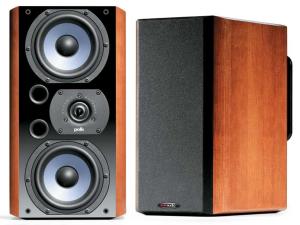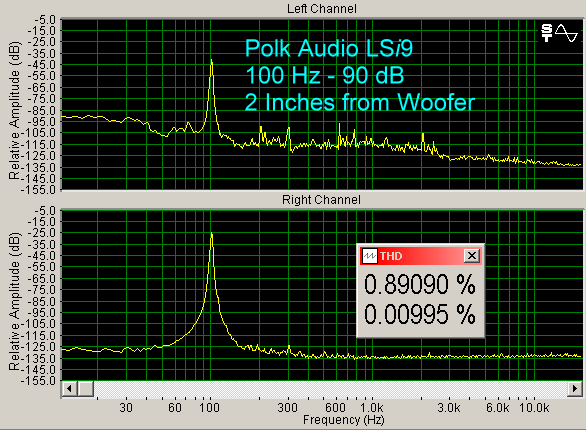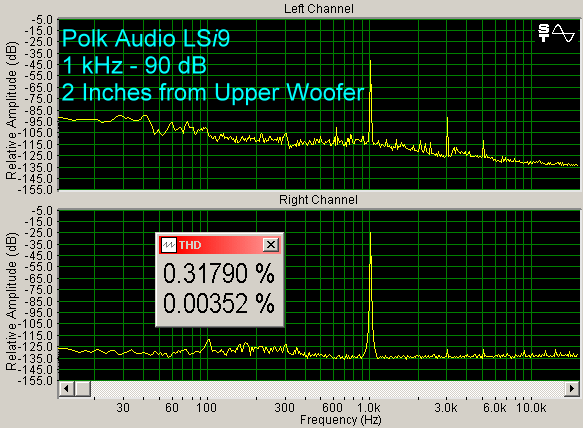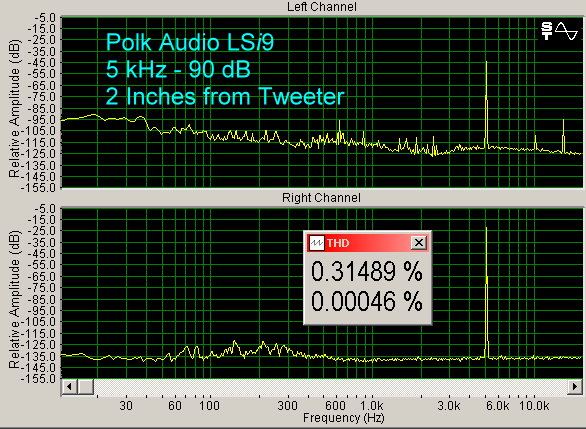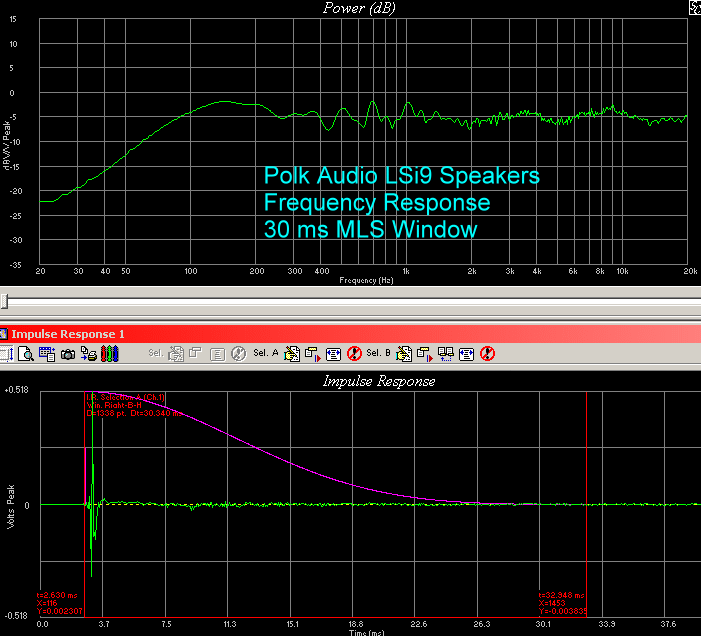|
|||||||||||||||||||||||
|
Introduction Over the years, Polk went quite a bit down-market, and established relationships with several mass market chain retailers. The volume of speakers sold increased, but Polk no longer appealed as much to the more discriminating buyer. Polk is now trying to go a bit up-market again with the introduction of the LSi series. The LSi9 is one of the “bookshelf” models in this lineup (second up in the series), and it's quite the unique loudspeaker. The Design The LSi9 is deeper than the average bookshelf speaker, and has a rear port with a baffle that diverts the air to the sides. This baffle, called the "Power Port", is designed to allow the speaker to be placed close to a wall. The speaker is a 2 ½ way design, as the bottom woofer works up to 200 Hz, the top woofer to 2.4 kHz, and from there on the center mounted tweeter takes over.
The speaker is constructed of ¾ inch MDF sides, and has a layer of
either ebony or cherry veneer over it. Rapping on the speakers shows that
they are fairly well built and inert. The tops and bottom have a shiny black
polished surface, and the front grille is black. On the front are two small
ports that are termed "Acoustic Resonance Control Ports", and are supposedly
designed to help midrange performance by increasing vocal clarity, image
stability, and image depth. The gold-plated binding posts on the rear are set up to
allow bi-wiring, but the posts were too thick for my spade terminated
speaker wires, so I would recommend banana plugs. These were done with the grilles on and off, and it was noted that the sound was a bit clearer without the grilles. The LSi9s have a slightly recessed high end, the tweeter has a decent amount of airiness to it, but it never approaches being bright. The midrange section is somewhat recessed also, and a bit more so than the upper end, with some chestiness to the lower midrange/upper bass. The Polk specializes in bass, and makes quite a bit of it for a “bookshelf” speaker. This is not the tight, polite bass of a B&W Nautilus 805, but bass of a looser type in much more copious amounts. The engineering that Polk did with the length, the ports, and the general size of these speakers appears to ensure that it makes as much bass as possible. If I could be so bold, the Polk exemplifies the “American Sound,” which is a bit more boomy and brash than the “English Sound,” which is a bit smoother and bass shy.
The problem with this approach is that although the
soundstage of the Polks is quite large, it is difficult to escape the
feeling that the music is coming from within a box. The midrange and lower
midrange are somewhat recessed and have that bit of aforementioned
chestiness, and this does not allow the speaker to open up and disappear.
One of the attractions of the “bookshelf” speaker has been the ability to
form a smaller point source, but the Polks appear to have crossed the
barrier into being large enough where some of this advantage is lost. When
you listen to Billy Joel “The Stranger,” drum taps sound as if they are
coming from a box, and not from a stage. This is not to say the Polk does
not have a wide soundstage, rather this was one of the most impressive
things about the speaker, as it has quite the large, deep soundstage. I was
not expecting that from this speaker, and the LSi9s also do a fairly
good job of imaging. The Polk provides a handsome cabinet, a reasonably smooth high end, slightly recessed midrange but with reasonable smoothness, and a copious full lower end. The very fact that this speaker was designed to make bass with its rear port baffle diverter and large size is the very reason that the midrange and the high end seem a bit recessed, as the bass can overwhelm them. Many people very much prefer this sound, as it can make rock music and hip hop sound alive and dramatic. In fact, using a brighter amp than my Classe (which has a slightly recessed top end) would probably work well with the Polks, perhaps bringing its upper end slightly forward and balancing it with the lower end. On the Bench (JEJ) A 100 Hz sine wave input, at 90 dB, 2 inches from the lower woofer, yielded a very good THD of less than 1%
With 1 kHz input, and measured at the upper woofer, the distortion spectrum is very good also, having just a couple of harmonic peaks at 3 kHz and 5 kHz. THD was less than 0.5%. These are odd-ordered harmonics. There don't appear to be any significant even-ordered harmonics.
At 5 kHz input, measured at the tweeter, THD was very low, and there were two harmonic peaks, a small second order peak at 10 kHz , and a larger third order peak at 15 kHz (there were no peaks beyond that).
The frequency response of the LSi9 is very smooth, and the bass emphasis that Manoj heard can be seen between 100 Hz and about 220 Hz. The chestiness is attributed to a small peak around 700 Hz. However, the overall response is quite good.
Conclusions
Those looking for their speakers to have a smoother midrange and airier top
end in this price range will find their way to something like the B&W
CDM1NT, but in the process will lose the dynamic bass and punch of the Polks.
For those whose listening tastes tend toward classical or jazz music, that
may be the path to go, but it well be worth trying the Polk LSi9s to see how
their approach will affect how you listen to music. For the rest of you
looking for dynamic speakers for home theater, or who just want to rock, the
Polks are well worth your consideration.
|
|||||||||||||||||||||||

